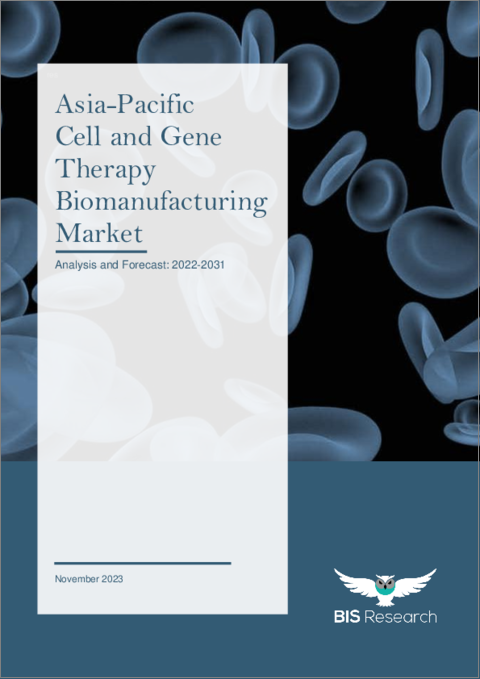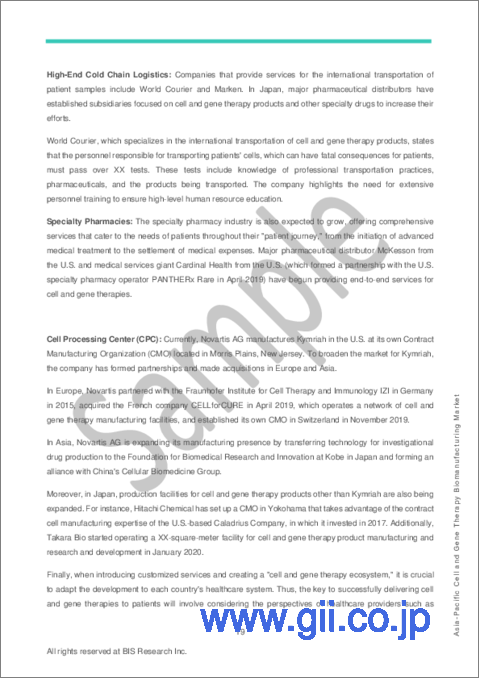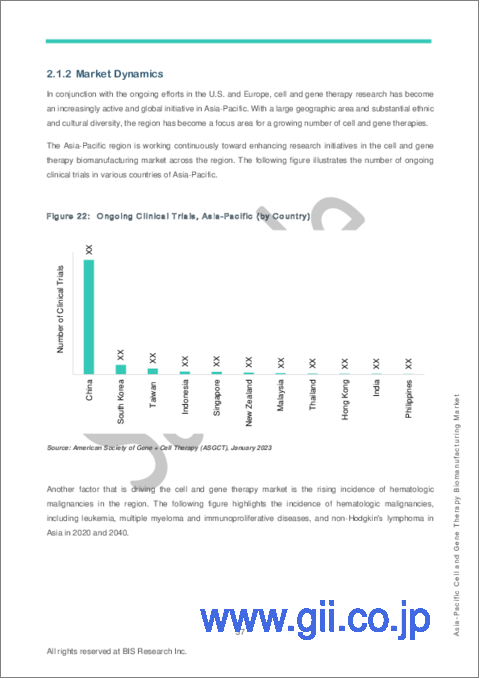|
|
市場調査レポート
商品コード
1379167
アジア太平洋地域の細胞・遺伝子治療バイオマニュファクチャリング市場:2022-2031年Asia-Pacific Cell and Gene Therapy Biomanufacturing Market - Analysis and Forecast, 2022-2031 |
||||||
カスタマイズ可能
|
|||||||
| アジア太平洋地域の細胞・遺伝子治療バイオマニュファクチャリング市場:2022-2031年 |
|
出版日: 2023年11月10日
発行: BIS Research
ページ情報: 英文 108 Pages
納期: 1~5営業日
|
- 全表示
- 概要
- 図表
- 目次
アジア太平洋地域の細胞・遺伝子治療バイオマニュファクチャリングの市場規模は、2022年の19億6,000万米ドルから、予測期間中は17.88%のCAGRで推移し、2031年には86億米ドルの規模に成長すると予測されています。
同市場は、認可済みの治療法の増加やインフラ要件の高まりなどから、成長が見込まれています。また、遺伝子・細胞治療の適応症の拡大から、広範なバイオマニュファクチャリング能力も求められています。
アジア太平洋地域の細胞・遺伝子治療バイオマニュファクチャリング業界は、急速な拡大と変化の時期を迎えようとしています。この地域は、認可済み医薬品の増加やインフラ要件の高まりから、最先端のバイオマニュファクチャリングの中心地になろうとしています。同地域での大規模バイオマニュファクチャリング施設に対する大きなニーズは、遺伝子・細胞治療の対象適応症の拡大によってもたらされています。市場は、政府、製薬企業、学術機関による継続的投資によっても成長しており、新しい生命を救う薬物療法の開発に役立っています。
当レポートでは、アジア太平洋地域の細胞・遺伝子治療バイオマニュファクチャリングの市場を調査し、市場概要、市場成長への各種影響因子の分析、法規制環境、市場規模の推移・予測、各種区分・地域/主要国別の詳細分析、競合情勢、主要企業の分析などをまとめています。
| 主要市場統計 | |
|---|---|
| 予測期間 | 2022-2031年 |
| 2022年評価 | 19億6,000万米ドル |
| 2031年予測 | 86億米ドル |
| CAGR | 17.88% |
市場区分:
セグメンテーション1:製品タイプ別
- 消耗品
- 装置
- ソフトウェア・ソリューション
セグメンテーション2:エンドユーザー別
- ライフサイエンス企業
- CRO
- CMO
- 細胞バンク
セグメンテーション3:国別
- 中国
- 日本
- インド
- 韓国
- オーストラリア/ニュージーランド
- その他のアジア太平洋地域
主要企業:
|
目次
第1章 市場
- 業界の展望
- 市場概要とエコシステム
- 主要動向
- 機会の評価
- 規制の枠組み
- 製品のベンチマーク
- 特許分析
- ビジネスモデル分析
- パイプライン製品
- 技術導入マトリックス
- 資金調達シナリオ
- 主要な成功要因
- COVID-19が細胞・遺伝子治療バイオマニュファクチャリング市場に与える影響
- ロシア・ウクライナ戦争が細胞・遺伝子治療バイオマニュファクチャリング市場に与える影響
第2章 アジア太平洋
- アジア太平洋
- 主な調査結果と機会の評価
- 市場力学
- 市場規模・予測分析
第3章 市場:競合ベンチマーキング・企業プロファイル
- 競合ベンチマーキング
- 企業シェア分析
- 企業プロファイル
List of Figures
- Figure 1: Cell and Gene Therapy Biomanufacturing Market, $Billion, 2021-2031
- Figure 2: Cell and Gene Therapy Biomanufacturing Market: Drivers, Restraints, and Opportunities
- Figure 3: Asia-Pacific Cell and Gene Therapy Biomanufacturing Market, Impact Analysis
- Figure 4: Cell and Gene Therapy Biomanufacturing Market (by Product Type), $Billion, 2021-2031
- Figure 5: Asia-Pacific Cell and Gene Therapy Biomanufacturing Market (by Region), $Billion, 2021 and 2031
- Figure 6: Asia-Pacific Cell and Gene Therapy Biomanufacturing Market, Share of Key Developments and Strategies (by Category), January 2020-January 2023
- Figure 7: Asia-Pacific Cell and Gene Therapy Biomanufacturing Market Segmentation
- Figure 8: Asia-Pacific Cell and Gene Therapy Biomanufacturing Market: Research Methodology
- Figure 9: Primary Research Methodology
- Figure 10: Bottom-Up Approach (Segment-Wise Analysis)
- Figure 11: Top-Down Approach (Segment-Wise Analysis)
- Figure 12: Market Overview and Ecosystem
- Figure 13: Insights on Strategies Adopted by Major Players, January 2020-January 2023
- Figure 14: Asia-Pacific Cell and Gene Therapy Biomanufacturing Market, Key Trends, Market Shift, 2022-2031
- Figure 15: TcBuster vs. Viral Gene Engineering Technology, Comparative Analysis
- Figure 16: Asia-Pacific Cell and Gene Therapy Biomanufacturing Market, Patent Analysis (by Year), January 2020-December 2022
- Figure 17: Asia-Pacific Cell and Gene Therapy Biomanufacturing Market, Patent Analysis (by Country), January 2020-December 2022
- Figure 18: Anticipated Regulatory Milestones in 2023
- Figure 19: Anticipated Regulatory Approval, U.S. and EU, 2023
- Figure 20: Asia-Pacific Cell and Gene Therapy Biomanufacturing Market, Technology Adoption Matrix
- Figure 21: Asia-Pacific Cell and Gene Therapy Biomanufacturing Market, Key Success Factors
- Figure 22: Impact of COVID-19 on CGT Developmental Activities
- Figure 23: Progress in Cell and Gene Therapy (CGT) Regulation during COVID-19
- Figure 24: Ways to Increase Supply Chain and Manufacturing
- Figure 25: Impact on Biopharmaceutical Industries
- Figure 26: Cell and Gene Therapy Biomanufacturing Market Share (by Region)
- Figure 27: Asia-Pacific Cell and Gene Therapy Biomanufacturing Market Incremental Revenue Opportunity (by Country), $Billion, 2021-2031
- Figure 28: Ongoing Clinical Trials, Asia-Pacific (by Country)
- Figure 29: Incidence of Hematologic Malignancies, Asia, 2020 vs. 2040
- Figure 30: Asia-Pacific Cell and Gene Therapy Biomanufacturing Market, $Billion, 2021-2031
- Figure 31: Asia-Pacific Cell and Gene Therapy Biomanufacturing Market (by Product Type), $Billion, 2021-2031
- Figure 32: Asia-Pacific Cell and Gene Therapy Biomanufacturing Market (by End User), $Billion, 2021-2031
- Figure 33: China Cell and Gene Therapy Biomanufacturing Market, $Billion, 2021-2031
- Figure 34: China Cell and Gene Therapy Biomanufacturing Market (by Product Type), $Billion 2021-2031
- Figure 35: China Cell and Gene Therapy Biomanufacturing Market (by End User), $Billion 2021-2031
- Figure 36: Japan Cell and Gene Therapy Biomanufacturing Market, $Billion, 2021-2031
- Figure 37: Japan Cell and Gene Therapy Biomanufacturing Market (by Product Type), $Billion 2021-2031
- Figure 38: Japan Cell and Gene Therapy Biomanufacturing Market (by End User), $Billion 2021-2031
- Figure 39: Incidence of Leukemia, Multiple Myeloma and Immunoproliferative Diseases, and Non-Hodgkin's Lymphoma, India, 2020 vs. 2040
- Figure 40: India Cell and Gene Therapy Biomanufacturing Market, $Billion, 2021-2031
- Figure 41: India Cell and Gene Therapy Biomanufacturing Market (by Product Type), $Billion 2021-2031
- Figure 42: India Cell and Gene Therapy Biomanufacturing Market (by End User), $Billion 2021-2031
- Figure 43: Incidence of Leukemia, Multiple Myeloma and Immunoproliferative Diseases, and Non-Hodgkin's Lymphoma, South Korea, 2020 vs. 2040
- Figure 44: South Korea Cell and Gene Therapy Biomanufacturing Market, $Billion, 2021-2031
- Figure 45: South Korea Cell and Gene Therapy Biomanufacturing Market (by Product Type), $Billion 2021-2031
- Figure 46: South Korea Cell and Gene Therapy Biomanufacturing Market (by End User), $Billion 2021-2031
- Figure 47: Australia/New Zealand Cell and Gene Therapy Biomanufacturing Market, $Billion, 2021-2031
- Figure 48: New Zealand Cell and Gene Therapy Biomanufacturing Market (by Product Type), $Billion 2021-2031
- Figure 49: Australia/New Zealand Cell and Gene Therapy Biomanufacturing Market (by End User), $Billion 2021-2031
- Figure 50: Rest-of-Asia-Pacific Cell and Gene Therapy Biomanufacturing Market, $Billion, 2021-2031
- Figure 51: Rest-of-Asia-Pacific Cell and Gene Therapy Biomanufacturing Market (by Product Type), $Billion 2021-2031
- Figure 52: Rest-of-Asia-Pacific Cell and Gene Therapy Biomanufacturing Market (by End User), $Billion 2021-2031
- Figure 53: Growth Share Analysis for Asia-Pacific Cell and Gene Therapy Biomanufacturing Market (by Product Type), 2021-2031
- Figure 54: Growth Share Analysis for Asia-Pacific Cell and Gene Therapy Biomanufacturing Market (by Application), 2021-2031
- Figure 55: Competitive Index, Unmet Needs, Solutions, and Impacts
- Figure 56: Company Position Analysis
- Figure 57: Asia-Pacific Cell and Gene Therapy Biomanufacturing Market, Total Number of Key Developments, January 2020-January 2023
- Figure 58: Funding Activities, January 2020-January 2023
- Figure 59: New Offerings, January 2020-September 2023
- Figure 60: Mergers and Acquisitions, January 2020-January 2023
- Figure 61: Partnerships, Alliances, and Business Expansion Activities, January 2020-January 2023
- Figure 62: Asia-Pacific Cell and Gene Therapy Biomanufacturing Market, Company Share Analysis, % Share, 2021
- Figure 63: WuXi AppTec: Product Portfolio
List of Tables
- Table 1: Key Questions Answered in the Report
- Table 2: Single-Use and Stainless-Steel Facilities, Comparative Analysis
- Table 3: Asia-Pacific Regulatory Scenario: Cell and Gene Therapy Biomanufacturing Market
- Table 4: Asia-Pacific Cell and Gene Therapy Biomanufacturing Market (by Product Type), Product Benchmarking
- Table 5: Comparative Analysis of Various Bioreactors Offered by Key Players
- Table 6: Asia-Pacific Cell and Gene Therapy Biomanufacturing Market, Awaited Technologies
- Table 7: Business Models, Key Features
- Table 8: Asia-Pacific Cell and Gene Therapy Biomanufacturing Market Dynamics, Impact Analysis
- Table 9: Approved Cell and Gene Therapies, Japan
- Table 10: Ongoing Industry Sponsored Cell and Gene Therapy Clinical Trials
- Table 11: Asia-Pacific Cell and Gene Therapy Biomanufacturing Market, Key Development Analysis, January 2020-January 2023
“The Asia-Pacific Cell and Gene Therapy Biomanufacturing Market Expected to Reach $8.60 Billion by 2031.”
| KEY MARKET STATISTICS | |
|---|---|
| Forecast Period | 2022 - 2031 |
| 2022 Evaluation | $1.96 Billion |
| 2031 Forecast | $8.60 Billion |
| CAGR | 17.88% |
Introduction to Asia-Pacific (APAC) Cell and Gene Therapy Biomanufacturing Market
The Asia Pacific (APAC) Cell and Gene Therapy Biomanufacturing Market is expected to grow at a CAGR of 17.88% from $1.96 Billion in 2022 to $8.60 Billion in 2031 in the forecasted period of 2022-2031. APAC cell and gene therapy biomanufacturing industry is expected to grow due in part to the increasing number of authorized treatments and growing infrastructural requirements. Extensive biomanufacturing capabilities are also required due to the expanding target indications for gene and cell treatments.
Market Introduction
The industry for cell and gene therapy biomanufacturing in Asia-Pacific (APAC) is about to undergo a period of rapid expansion and change. This area is set to become a center for state-of-the-art biomanufacturing due to the rise of authorized medicines and the rising requirements for infrastructure. A significant need for large-scale biomanufacturing facilities in Asia-Pacific is being driven by the broadening range of target indications for gene and cell therapies. The APAC market for cell and gene therapy biomanufacturing is growing as a result of continued investment in this area by governments, pharmaceutical corporations, and academic organizations, which is helping to develop novel and perhaps life-saving medical therapies. In addition to seeing the creation of cutting-edge treatments, this area is essential to the world's biomanufacturing industry.
Market Segmentation:
Segmentation 1: by Product Type
- Consumables
- Equipment
- Software Solutions
Segmentation 2: by End User
- Life Science Companies
- Contract Research Organizations (CROs)
- Contract Manufacturing Organizations (CMOs)
- Cell Banks
Segmentation 3: by Country
- China
- Japan
- India
- South Korea
- Australia/New Zealand
- Rest-of-Asia-Pacific
Demand - Drivers and Limitations
The following are the drivers for the Asia-Pacific Cell and Gene Therapy Biomanufacturing Market:
- Expansion in Target Indications for Cell and Gene Therapies Creating a Demand for Large-Scale Biomanufacturing
- Entry of New Market Participants in Cell and Gene Therapies Driving the Demand for Biomanufacturing Facilities and Equipment
- Robust Clinical Pipeline Creating a Demand for Biomanufacturing Infrastructure
The market is expected to face some limitations as well due to the following challenges:
- High Set-Up Cost of Biomanufacturing Facilities
How can this report add value to an organization?
Workflow/Innovation Strategy: The APAC cell and gene therapy biomanufacturing market (by product type) has been segmented into consumables, equipment, and software solutions.
Growth/Marketing Strategy: Cell and gene therapy biomanufacturing is being used for upstream processing, harvesting, downstream processing, and other applications. Various companies are providing consumables and equipment aid in the manufacturing of various cell and gene therapies, which is also the key strategy for market players to excel in the current cell and gene therapy biomanufacturing market.
Competitive Strategy: Key players in the APAC cell and gene therapy biomanufacturing market have been analyzed and profiled in the study, including manufacturers involved in new product launches, acquisitions, expansions, and strategic collaborations. Moreover, a detailed competitive benchmarking of the players operating in the APAC cell and gene therapy biomanufacturing market has been done to help the reader understand how players stack against each other, presenting a clear market landscape. Additionally, comprehensive competitive strategies such as partnerships, agreements, and collaborations will aid the reader in understanding the untapped revenue pockets in the market.
Key Market Players and Competition Synopsis
The companies that are profiled have been selected based on inputs gathered from primary experts and analysing company coverage, product portfolio, and market penetration.
Some of the prominent names established in this market are:
|
Table of Contents
1 Markets
- 1.1 Industry Outlook
- 1.1.1 Market Overview and Ecosystem
- 1.1.2 Key Trends
- 1.1.2.1 Biomanufacturing 4.0
- 1.1.2.2 Growing Single-Use Technology Market Penetration
- 1.1.2.3 Shift from Open Processing to Closed Processing for Cell and Gene Therapy Biomanufacturing
- 1.1.2.4 Leveraging Various Key Strategies to Diversify the Product Portfolio
- 1.1.3 Opportunity Assessment
- 1.1.4 Regulatory Framework
- 1.1.5 Product Benchmarking
- 1.1.5.1 Product Benchmarking (by Product Type)
- 1.1.5.2 Comparative Analysis (by Equipment)
- 1.1.6 Patent Analysis
- 1.1.6.1 Patent Analysis (by Year)
- 1.1.6.2 Patent Analysis (by Country)
- 1.1.6.3 Awaited Technologies
- 1.1.7 Business Model Analysis
- 1.1.8 Pipeline Products
- 1.1.9 Technology Adoption Matrix
- 1.1.10 Funding Scenario
- 1.1.11 Key Success Factors
- 1.2 Impact of COVID-19 on the Cell and Gene Therapy Biomanufacturing Market
- 1.2.1 Recommendations to Manufacturers
- 1.3 Impact of Russo-Ukrainian War on Cell and Gene Therapy Biomanufacturing Market
2 Asia-Pacific
- 2.1 Asia-Pacific
- 2.1.1 Key Findings and Opportunity Assessment
- 2.1.2 Market Dynamics
- 2.1.2.1 Impact Analysis
- 2.1.3 Sizing and Forecast Analysis
- 2.1.3.1 Asia-Pacific Cell and Gene Therapy Biomanufacturing Market (by Product Type)
- 2.1.3.2 Asia-Pacific Cell and Gene Therapy Biomanufacturing Market (by End User)
- 2.1.3.3 Asia-Pacific Cell and Gene Therapy Biomanufacturing Market (by Country)
- 2.1.3.3.1 China
- 2.1.3.3.1.1 China Cell and Gene Therapy Biomanufacturing Market (by Product Type)
- 2.1.3.3.1.2 China Cell and Gene Therapy Biomanufacturing Market (by End User)
- 2.1.3.3.2 Japan
- 2.1.3.3.2.1 Japan Cell and Gene Therapy Biomanufacturing Market (by Product Type)
- 2.1.3.3.2.2 Japan Cell and Gene Therapy Biomanufacturing Market (by End User)
- 2.1.3.3.3 India
- 2.1.3.3.3.1 India Cell and Gene Therapy Biomanufacturing Market (by Product Type)
- 2.1.3.3.3.2 India Cell and Gene Therapy Biomanufacturing Market (by End User)
- 2.1.3.3.4 South Korea
- 2.1.3.3.4.1 South Korea Cell and Gene Therapy Biomanufacturing Market (by Product Type)
- 2.1.3.3.4.2 South Korea Cell and Gene Therapy Biomanufacturing Market (by End User)
- 2.1.3.3.5 Australia/New Zealand
- 2.1.3.3.5.1 Australia/New Zealand Cell and Gene Therapy Biomanufacturing Market (by Product Type)
- 2.1.3.3.5.2 Australia/New Zealand Cell and Gene Therapy Biomanufacturing Market (by End User)
- 2.1.3.3.6 Rest-of-Asia-Pacific
- 2.1.3.3.6.1 Rest-of-Asia-Pacific Cell and Gene Therapy Biomanufacturing Market (by Product Type)
- 2.1.3.3.6.2 Rest-of-Asia-Pacific Cell and Gene Therapy Biomanufacturing Market (by End User)
- 2.1.3.3.1 China
3 Markets - Competitive Benchmarking and Company Profiles
- 3.1 Competitive Benchmarking
- 3.1.1 Competitive Landscape
- 3.1.1.1 Segmental Growth Share Matrix
- 3.1.1.1.1 Growth Share Analysis (by Product Type)
- 3.1.1.1.2 Growth Share Analysis (by Application)
- 3.1.1.2 Competitive Index (Unmet Needs and Innovations)
- 3.1.1.3 Company Position Analysis
- 3.1.1.4 Key Strategies and Developments
- 3.1.1.4.1 Funding Activities
- 3.1.1.4.2 New Offerings
- 3.1.1.4.3 Mergers and Acquisitions
- 3.1.1.4.4 Partnerships, Alliances, and Business Expansions
- 3.1.1.4.5 Key Development Analysis
- 3.1.1.1 Segmental Growth Share Matrix
- 3.1.1 Competitive Landscape
- 3.2 Company Share Analysis
- 3.3 Company Profiles
- 3.3.1 WuXi AppTec
- 3.3.1.1 Company Overview
- 3.3.1.2 Role of WuXi AppTec in the Cell and Gene Therapy Biomanufacturing Market
- 3.3.1.3 Major Product: Key Specifications
- 3.3.1.4 Customers and Competitions/Opportunities
- 3.3.1.4.1 Key Competitors
- 3.3.1.5 Analyst Perspective
- 3.3.1 WuXi AppTec






